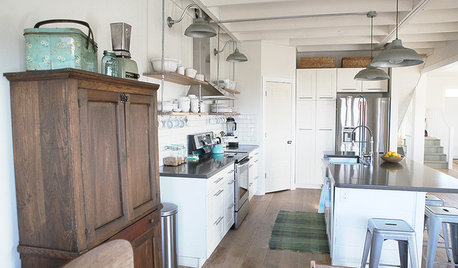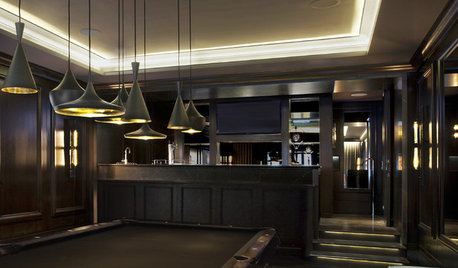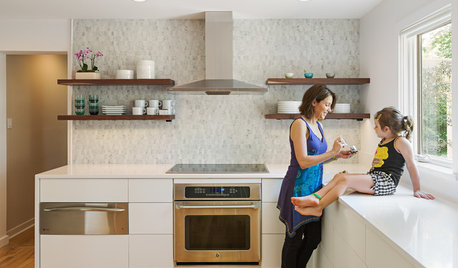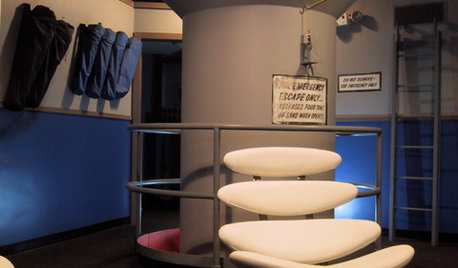What wire to run in an underground conduit?
What would be the best choice of wire to run in an underground conduit?
I am running electricity to my barn, have dug the trench and wonder what would be the best choice of wire to use. I know that there is direct burial wire but I do want to run the wire in conduit to protect it. Should I run, say, UF-B inside the conduit for further protection, in case moisture forms in the conduit?
Here are the parameters.
- 50 foot run from house to barn
- Depth of trench 24"
- Wire gauge: would prefer 10 (It is a 20 amp circuit but would prefer to use 10 gauge in case I decide to one day upgrade the rest of the circuit).
- Conduit: Intend to use the standard grey PVC, 1" or 1 "
Thanks
Comments (22)
orourke
Original Author14 years agolast modified: 9 years agoThanks for the info.
One more question came up: I want to also run a phone line and/or network cable (will most likely use the computer in the barn sometimes so would like to have DSL).
Should I run the phone line in a separate conduit? I dont know if code allows running the phone/data and power line in the same conduit, but in any case, Im also concerned that having the phone line run next to the power line for such a long stretch (50 ft) might induce crosstalk into the phone/data lines.
Also, should the telephone wire in the conduit be regular phone wire? Is there special phone/data wire for running in conduit underground?
Related Professionals
The Crossings General Contractors · Chicago Ridge General Contractors · Clarksville General Contractors · Dorchester Center General Contractors · Goldenrod General Contractors · Poquoson General Contractors · Waldorf General Contractors · Wheaton General Contractors · Springdale Handyman · Gardena Solar Energy Systems · Hinsdale Solar Energy Systems · Syosset Solar Energy Systems · Wakefield Solar Energy Systems · Ponte Vedra Beach Home Automation & Home Media · Waterford Home Automation & Home Mediabryanlm
14 years agolast modified: 9 years agoAbout the phone wire the only time it is allowable to run the phone and cable by each other is if they cross over each other at 1 point. I have actually never ran into having any kind of interferance to be totally honest and i work as a electrician currently. You can get some direct burial rated phone wire and if you cover the conduit with 2-3# of dirt to be safe and then throw your phone line in then you will be more then protected from any kind of interferance that you probably wouldn't have to worry about anyways.
Ron Natalie
14 years agoThere's no code rule on "crossing phone wires". It's just a fear of coupling soe hum into the phone wire. Frankly, it's widely ignored by even the phone company. My incoming phone wire is wire tied to the 400A feed (the phone company loves to put the NID right next to the electric meter because it's easier to get to the ground system that way).
Unlike thermostat wiring, phone wiring insulation is rated high enough. I still would not want to put any terminations in a box with 120/240V terminations in it.
The fact that you are running a phone wire reinforces that you MUST run four conductors to the new structure (HOTS, GROUND, and NEUTRAL). It was a good idea to do this anyhow.
brickeyee
14 years agolast modified: 9 years ago"Frankly, it's widely ignored by even the phone company."
It is ignored because the phone has a filter that cuts out at around 300 Hz, with notches at 60 Hz and 120 Hz.
The 60 Hz field couples ino everything, and any equipment that cannot deal with it was poorly designed (not as uncommon as you might think).
jmvd20
14 years agolast modified: 9 years agoIf I were you I would install 1 1/2" PVC conduit for the electrical and 3/4" PVC for the phone line. The difference in material cost from 1" to 1 1/2" PVC is negligible and you have already done the hard part which is digging the trench.
While 1 1/2" may be way oversized for what you have now in the future you may want a welder or something out there and with that size conduit you can upgrade the wiring without having to dig and install another conduit.
The reason I recommend using 3/4" PVC for the phone line is that if you ever want to add cable TV, or a wired security system etc... you already have the conduit in place and simply need to pull the wires. I am glad I used this on my own garage as I just added a TV out there and pulled some coax into it in no time.
Of course all of this advice assumes you hate digging trenches as much as I do.
Ron Natalie
14 years agoThe latter is a good point (running two conduits). Trying to pull something through a conduit with three or four large conductors already in it is going to be a pain in the rear. Having a separate conduit for your phone/video will make future technology changes a lot easier.
gblentz
14 years agolast modified: 9 years agoCompletely agree with the separate conduit for phone, except I'd go with 1". The additional cost is negligible and, if at some point you decide you want cable for TV, network, alarm, signaling, etc., it's easier to pull with wire-in-place if you have a larger diameter.
12" of separation between your low-voltage and line conductors will provide adequate noise isolation for up to 5kVA in free air... in-ground should give you even greater.
The main point is to do the one while you're doing the other.
Conduit is cheap... trenching, no so much.
terribletom
14 years agolast modified: 9 years ago3 wires or 4? There's something here that I think may need disambiguating, since it isn't at all clear to me whether the OP is planning a single 120V circuit or a two-pole circuit.
In case this needs clarifying (maybe it's just me?), I believe O'Rourke has the following viable options:
1. A three-wire, 20-amp, 120V single branch circuit (black, white, ground). This would provide only minimum power with the fewest options for future expansion. It has the minor advantage of potentially simplifying a few things about the installation (e.g., no grounding rod or breaker panel required).
2. A 4-wire 20-amp multi-wire branch circuit (MWBC--black, red, white, ground). Basically the same advantages as #1 except that it doubles the available power because it can functionally "split" into two 20-amp circuits inside the building. (Also, can readily be reworked for 120/240V service at a later time.)
3. 4-wire 30-amp 120/240V service (black, red, white, ground). Has the potential benefit of making 240V power available, which could prove advantageous for something like a well-pump, larger power tool, etc. This option requires a small subpanel and grounding electrode(s). A small box like this might be expandable to as many as four 120V circuits (2 x 20A plus 2 x 15A) or, if a modest 240V capability is needed, then three circuits (2 x 20A @120V plus 1 x 15A @240V).
The "option" that is NOT available is a three-wire 120/240V feed. That's definitely off the table not only because of the phone wire between buildings, but also (potentially) because three-wire service is being phased out by the 2008 Code. To my way of thinking, even without the phone line (or other metallic connection between buildings), it's an anchronism even if it'd be technically legal in an area that hasn't adopted the 2008 NEC.
Though a single 20A circuit may be the immediate objective, a four-wire pull is by far the best long-term approach for expansion, even if one of the wires goes unused for the time being. With a 50-foot run, we're only talking about maybe $35-40 difference in cost.
If what the OP plans is a single 120V circuit with two #10 wires plus ground, it strikes me as underkill if s/he really wants to expand later and overkill for a single circuit. It's not a terrific straddle, IMO.
Jes my take...
buckeyeinwi
14 years agolast modified: 9 years agoyou can run up to 55 amps into THHN 10 gauge...I know you will say I am nuts, but look "ugly's handbook". I would use schedule 80 PVC, and not metal conduit, also use a number 12 ground. You can run 3 #10's and a #12 for ground through a 1" run.... So you could have a 100 amp panel.
jmvd20
14 years agolast modified: 9 years ago"you can run up to 55 amps into THHN 10 gauge...I know you will say I am nuts, but look "ugly's handbook". I would use schedule 80 PVC, and not metal conduit, also use a number 12 ground. You can run 3 #10's and a #12 for ground through a 1" run.... So you could have a 100 amp panel."
There is nothing accurate in this post.
Hopefully it is an attempt at some sort of humor...
petey_racer
14 years agolast modified: 9 years agobuckeyeinwi, put the Ugly's down and curl up with the real NEC for a few weeks. You'll be amazed at what you find.
orourke
Original Author14 years agolast modified: 9 years agoI am not being very successful at finding THWN wire. The usual stores (Home Depot, Lowes) do not carry it, they only carry THHN. I also called four electrical supplies some carried THWN, but only in 500ft spools!
They all assure me that electricians routinely run THHN type cable underground in conduit.
Any thoughts?
And two more questions came up reading terribletoms very helpful list of wring options:
a) Can I run 4 wire (white,black,red+ground) (either 12 or 10AWG) and use the white and black in parallel for now (to reduce voltage drop) which, I assume, would leave me the option of reconfiguring it later to two independent circuits (same phase for just two 120V circuits or separate phases for 240V)? BTW, keeping expansion in mind, I did install a small 2-circuit subpanel in the barn with independent 20A breakers.
b) My house is old (1958) and is not grounded. However, I did run ground (green wire) in all the barn circuits. Can I simply not connect the green wire to the houses electrical supply (nowhere to connect it to anyway) and instead ground just the barn using a 6 or 8 grounding rod planted somewhere outside the barn?P.S. Thanks for all the great advice. I finished the conduit/trench work, now ready to run the wires - will post how it all worked out at the end.
Ron Natalie
14 years agoThe usual HD/Lowes employee is generally an idiot.
Go down to the store and pull about 1 foot of the wire off the spool and see if it isn't in fact labeled THHN/THWN. I bet it is.
If the wire is marked THHN only, you can be assured despite the idiot statement that it CAN NOT legally be used underground.
You can not use paralleled #12's. You only can legally parallel when you get up to the really big wires.
Your house, even without grounding conductors internally almost certainly has a grounding system (ground rods are most common). Given other metallic connections (phone, piping, cable) you will need to connect the two buildings grounding together. If there are no other connections, then it is optional (but still a good idea).
The only exception to this if you only had one circuit in the outbuilding, you could avoid having to put a separate grounding system in for that building, but the ground wire then is obligatory back to the main.
jmvd20
14 years agolast modified: 9 years agoorouke - check the insulation on the "THHN" wire they sell at home depot and Lowes. THHN from these places is USUALLY rated as THWN as well. If it has THHN/THWN then you are fine placing it underground. As a matter of fact I cannot recall the last time I saw THHN only.
jmvd20
14 years agolast modified: 9 years agoOops, I see Ron already had the THHN/THWN issue covered in his response. I think I was focused on some of the bumbling fools they can have working in the electrical departments at HD/Lowes/Menards. It isn't the people that work there who dont know anything that get to me - it is the people who don't know anything but pretend they know EVERYTHING that get to me.
Anyway - back on the topic at hand!
terribletom
14 years agolast modified: 9 years ago"Can I run 4 wire (white,black,red+ground) (either 12 or 10AWG) and use the white and black in parallel for now (to reduce voltage drop)
Even if you could use parallel wiring, at your run distance (~50'), I wouldn't worry about voltage drop; it won't a significant factor.
"same phase for just two 120V circuits or separate phases for 240V?
Not to make too big a deal about terminology, but your residential service doesn't have two phases; it's split-phase 120/240V with two poles or legs. Anyway, a lot of folks call them phases (incorrectly), so ain't no biggie there.
For what you're doing, though, it does help to understand a little about how split phase works. The power company's transformer has two poles and a "neutral" center core. If you wire something to both poles, you get 240V; if you wire to one of the poles and the neutral, you get 120V. An important thing to keep in mind is that the neutral, when it is used, is a current carrying conductor--it isn't inert. Think of it as a "return path" to the transformer when only one pole is used.
What's more, the neutral is bonded with ground and it's often called the grounded conductor, as distinguished from the equipment ground--the bare or green wire--that is A.K.A. the grounding conductor.
OK, then, here's how that trivia affects your questions:
You want the two hots on opposite poles in EACH of the two scenarios. For 240V, it's obvious why the the hots have to be on opposite poles.
Perhaps it's less obvious why that's the case for two 120V circuits with a shared neutral wire (i.e., the MWBC option). The reason for using opposite poles is to prevent overloading the neutral.
Let's say you were to put both circuits on the same pole. When they are both used, you would have the potential of drawing 40 amps (2 x 20A circuits) using a neutral (remember it's a current carrying conductor!) rated for only 20A (#12) or 30A (#10).
However, when the hots are on opposite poles, the currents "cancel" each other out--much like the two hots of a 240V circuit--with the neutral carrying only the imbalance between the two. Therefore, when you share a neutral, you must put the hots on opposite poles. The new code (2008) requires that you use a two-pole breaker as well. (That's to ensure that when one circuit is open, there isn't any current on the neutral from the other "half" of the MWBC.)
"My house is old (1958) and is not grounded. However, I did run ground (green wire) in all the barn circuits. Can I simply not connect the green wire to the houses electrical supply (nowhere to connect it to anyway) and instead ground just the barn using a 6 or 8 grounding rod planted somewhere outside the barn?The main panel in your house is most certainly grounded, whether or not the branch circuits have equipment grounding wires. And even if it doesn't have any ground rods, the neutral feeder (the grounded connector) is grounded by the power company and equipment ground wires (grounding conductors) are ultimately bonded to the same ground.
In the hopes of reducing some confusion, let me use another term: earthing. That's what's accomplished locally by ground rods and the primary purpose is to disperse lightning strikes to the earth.
So when we talk about grounding, we're really talking about two purposes: (1) lightning or other high-voltage surge and (2) equipment grounding for the purposes of tripping a circuit breaker in the event of a ground fault. For equipment grounding to fullfil its purpose, it must provide a good alternate fault path back to the transformer. (While this may be a slightly oversimplified explanation, it's a decent framework for understanding grounding and bonding.)
Because the earth is a remarkably poor conductor, if you try to use a ground rod alone for the purpose of equipment grounding at the barn, you'll end up with an unsafe condition, not to mention a code violation. In most soil and moisture conditions, there's simply too much resistance to conduct enough current back to the transformer to trip a breaker. So, lightening protection? Yes. Equipment grounding? Nope, inadequate.
When you imply (if I'm reading you correctly) that there isn't anywhere to connect the green grounding conductor in your house, are you overlooking the ground bar and/or neutral bar in your main panel? That's where the green equipment ground goes--so it has a direct, low-resistance path to the transformer's center core.
In wiring that small subpanel in the barn, here are the steps I recommend:
1. Maintain separate neutral and ground bars in that panel. (You may have to buy a small ground bar for a couple of bucks or, if there are two bars and they are connected, they need to be disconnected.)
2. In your house, connect the equipment ground wire to the ground bar. In a main panel, there is often only one bar, serving both neutrals and equipment grounds. (That's fine in a main panel. In a subpanel, however, they should be separated.)
3. At the barn, connect the equipment ground feeder to the subpanel ground bar and land your branch circuit ground wires there too.
4. Drive two 8' grounding electrodes (ground rods) at least 6' apart and connect them to the panel ground bar with #6 copper wire.
Note: There's a code exception for a single circuit feeding a detached building (options 1 & 2 in my post above) so you may not immediately need a ground rod at the barn. However, with expansion to more than one circuit, (a MWBC only counts as one!) code will definitely require local earthing at the barn.
Hope I've made this clearer instead of just muddying the waters.
orourke
Original Author14 years agolast modified: 9 years agoTerribletom, I appreciate all the detailed instructions. I happen to be a computer engineer and physicist by training so I understand some of the basics of 3-phase power generation and distribution but not the implementation details. So bear with me for one more round. I think you have given me enough information that Im on the verge of rationalizing all the suggestions you made.
I think I understand the ground rods providing some protection against lightning and other surges but not being conductive enough to create overcurrents that will trip a breaker (though surely strong enough currents to trip the GFCI I plan to place on the barn branch circuit). Actually, as a side note, I once measured an impedance of about 10 ohms in a ground rod circuit. Indeed not low enough to generate the 20amp overcurrent to trip a breaker at 120V.
I am starting to get the feeling that unless I establish a (green) equipment-ground wire in the house circuit and connect it to the main panel, there is no way to take electricity to the barn and still meet code.
More specifically,
I assume that by equipment-ground you mean the wire that is normally green in color but sometimes grey or bare copper.
1. Maintain separate neutral and ground bars in that panel. (You may have to buy a small ground bar for a couple of bucks or, if there are two bars and they are connected, they need to be disconnected.)
There is only one bar in the small barn subpanel. But no problem, say I buy a small separate ground bar.
2. In your house, connect the equipment ground wire to the ground bar. In a main panel, there is often only one bar, serving both neutrals and equipment grounds. (That's fine in a main panel. In a subpanel, however, they should be separated.)
There are no equipment-ground wires in any of my house wiring. That is, there are no green, gray or bare copper conductors anywhere. All wires in my house are 2 conductor wires, just one white and one black (hot+neutral). The only ground (bar) is inside the main panel where the neutral from the utility pole attaches.
See, for now, I was planning to feed the barn circuit from an existing, unused, 20amp two conductor (black+white) house circuit. This house circuit was originally used to feed an old radiant space heater in one of my bathrooms (that bathroom is the closest room to the barn anyway so tapping into that circuit for the barn is most convenient). I disconnected the old radiant heater a long time ago for safety reasons and since that was the only appliance on that circuit, this circuit is now unused and available, I assume, to feed the barn. But it is strictly a 2-conductor wire (black+white only).
3. At the barn, connect the equipment ground feeder to the subpanel ground bar and land your branch circuit ground wires there too.
In other words, all the (green) equipment-ground wires go to the subpanel ground bar. However, there is no existing (green) equipment ground wire coming from the house. If one is needed I would have to install one on a separate route and run it all the way to my houses main panel.
4. Drive two 8' grounding electrodes (ground rods) at least 6' apart and connect them to the panel ground bar with #6 copper wire.
Again, from what I understand, unless I install that (green) equipment-ground conductor from the house main panel to the barn, then I should probably not ground/earth the barn subpanel at all. If I do run the (green) equipment-ground wire from the barn to the houses main panel then I should probably ground/earth the main panel only using rods implanted somewhere close to the main panel.
Do I understand this correctly now?
P.S. After you posted, I also discovered this link , but none of the scenarios seem to describe my situation. Remember, I am trying to extend a 2 wire (black+white) only existing circuit to feed the barn. As I said, Im starting to suspect I should not do it unless I run an additional equipment-ground wire from the barn to the main panel.
Ron Natalie
14 years agoI'm not sure exactly what are proposing now, but your barn needs ground rods and it also needs the ground wire running with the new feeder.
terribletom
14 years agolast modified: 9 years agoAs the proud owner of a ca. 1825 farmhouse, I understand a lot of the challenges and adventures that come with playing "this old house", and it sounds like you have your share too!
That said, I have no idea what it might take to rework your plan to take power from the main panel instead of that unused two-wire ungrounded circuit. Any chance you could pull a new cable there with an equipment ground and maybe a bit more ampacity?
The lack of a ground at the point of hookup is definitely a problem and it all but guarantees that any "solution" you try will violate modern electrical codes.
I think I understand the ground rods providing some protection against lightning and other surges but not being conductive enough to create overcurrents that will trip a breaker (though surely strong enough currents to trip the GFCI I plan to place on the barn branch circuit).
Actually, equipment grounds have little or nothing to do with the operation of a GFCI. Because a GFCI works by monitoring the hot and neutral and only trips when they are out of balance, a GFCI doesn't even need a ground wire to function properly. But you should also keep in mind that, while a GFCI protects against ground faults, it doesn't provide overcurrent protection. Thus, in the case of a short circuit, the heat can start a fire while a GFCI continues to feed power!
"Actually, as a side note, I once measured an impedance of about 10 ohms in a ground rod circuit. Indeed not low enough to generate the 20amp overcurrent to trip a breaker at 120V."
Yep, you're spot on there and, actually, 10 ohms is better than average! With this in mind, you may have wondered why I recommended two ground rods. It's because recent code editions allow a single ground rod where the impedance is 25 ohms or less. If a single rod flunks this test, a second rod is required and many single rods do, in fact, flunk. Don't ask me why (practicality, I'd assume), but the two ground rods together don't have to pass the test--they're just presumed to be OK. So it ain't all pure science, if you catch my drift. :-)
"I am starting to get the feeling that unless I establish a (green) equipment-ground wire in the house circuit and connect it to the main panel, there is no way to take electricity to the barn and still meet code."
That's my take too.
"I assume that by equipment-ground you mean the wire that is normally green in color but sometimes grey or bare copper.
Yep. (While gray is technically designated as an alternate color for neutrals, those old green ground wires do sometimes look gray.)
1. Maintain separate neutral and ground bars in that panel. (You may have to buy a small ground bar for a couple of bucks or, if there are two bars and they are connected, they need to be disconnected.)
There is only one bar in the small barn subpanel. But no problem, say I buy a small separate ground bar.
If you still have the packaging materials, they'll probably say somewhere the correct part number with the notation "sold separately." (Thanks, folks.) It's best to use the designated part although, in truth, those short ground bars are fairly interchangeable.
2. In your house, connect the equipment ground wire to the ground bar. In a main panel, there is often only one bar, serving both neutrals and equipment grounds. (That's fine in a main panel. In a subpanel, however, they should be separated.)
There are no equipment-ground wires in any of my house wiring. That is, there are no green, gray or bare copper conductors anywhere. All wires in my house are 2 conductor wires, just one white and one black (hot+neutral). The only ground (bar) is inside the main panel where the neutral from the utility pole attaches.
See, for now, I was planning to feed the barn circuit from an existing, unused, 20amp two conductor (black+white) house circuit. This house circuit was originally used to feed an old radiant space heater in one of my bathrooms (that bathroom is the closest room to the barn anyway so tapping into that circuit for the barn is most convenient). I disconnected the old radiant heater a long time ago for safety reasons and since that was the only appliance on that circuit, this circuit is now unused and available, I assume, to feed the barn. But it is strictly a 2-conductor wire (black+white only).
Sigh, I feel your pain. (Really! No sarcasm intended.)
3. At the barn, connect the equipment ground feeder to the subpanel ground bar and land your branch circuit ground wires there too.
In other words, all the (green) equipment-ground wires go to the subpanel ground bar. However, there is no existing (green) equipment ground wire coming from the house. If one is needed I would have to install one on a separate route and run it all the way to my houses main panel.
True, true and true. (Not to get too picky here, but technically speaking, the EG is supposed to run in the same cable or raceway, btw.)
4. Drive two 8' grounding electrodes (ground rods) at least 6' apart and connect them to the panel ground bar with #6 copper wire.
Again, from what I understand, unless I install that (green) equipment-ground conductor from the house main panel to the barn, then I should probably not ground/earth the barn subpanel at all.
IMO, earthing the barn panel is a good thing in any event. What is to be avoided is a "false equipment ground". (That's a made-for-purpose term meaning that if the EG's are connected only to a grounding electrode, it may create a false confidence in addition to a code violation.)
Somewhat better (although not fully code compliant!) would be to bond the neutral and the grounding electrode at the barn's ground bar. (That is what is done with a so-called three-wire 120/240V outbuilding service--the neutral effectively serves to feed both grounded conductor and grounding conductor.)
But note that, as ronnatalie has correctly pointed out above, this approach is not strictly applicable in your case because there are other metallic connections (e.g., the phone wire) between buildings. Now that would take another long-winded discussion, but suffice it to say that the code only permits a neutral-EG bond when the house and outbuilding have no other connections. That may be a technical glitch, but it's a potential violation nonetheless.
If I do run the (green) equipment-ground wire from the barn to the houses main panel then I should probably ground/earth the main panel only using rods implanted somewhere close to the main panel.
If your house really has no earthing system, that would be a wise improvement in any case. It might also be useful to evaluate your plumbing as a potential source of earthing. If your water service is metalic when it enters the house, and runs at least 10 feet in the ground, you should also connect the water supply at the point of entry to your main electrical panel.
With an old house, seemingly simple projects do tend to mushroom, don't they?
orourke
Original Author14 years agolast modified: 9 years agoI believe I do understand most of it now (except for the GFCI which seems to me would still trip it seems to only take a 5mA imbalance- even if the grounding rods/earthing circuit are high resistance).
But to summarize the implied action items,
One of the easiest ways to do this properly would be for me to run a brand new 2008 code line (balck+white+green) from my main house panel, to the conduit that takes electricity to the barn. In addition I would also have to ground/earth my main panel.
So
A) My main panel is on my master bedrooms exterior wall, so
- from the main panel I would run metal conduit externally vertically down to the floor joist level
- then perforate stucco and rim joist to take conduit into the crawl space
- then horizontally via Rommex or Metal Sheath wire along the crawl space attached to the bottom of the joists until I reach the point of the house closest to the barn (that would be the spare bathroom),
- then perforate the rim joist and stucco again and then Im off into the conduit to the barn.B) At the main panel, I would establish a grounding bar, connect it to the neutral bar and also connect #6 copper wire from the main panel ground bar to two 8 grounding rods implanted presumably somewhere close to the main panel (preferably a moist soil area to get lower resistance?).
Then, with A) and B) done, any additional grounding rods by the barn would be a safety enhancement but not a mandatory one. At the barn subpanel, neutral bar and equipment ground bars would stay independent.
Sorry this got so convoluted, but I do certainly appreciate the tutorials.
Ron Natalie
14 years agoThe ground rods at the barn are MANDATORY!
You can not install a subpanel in the barn without them.



















terribletom